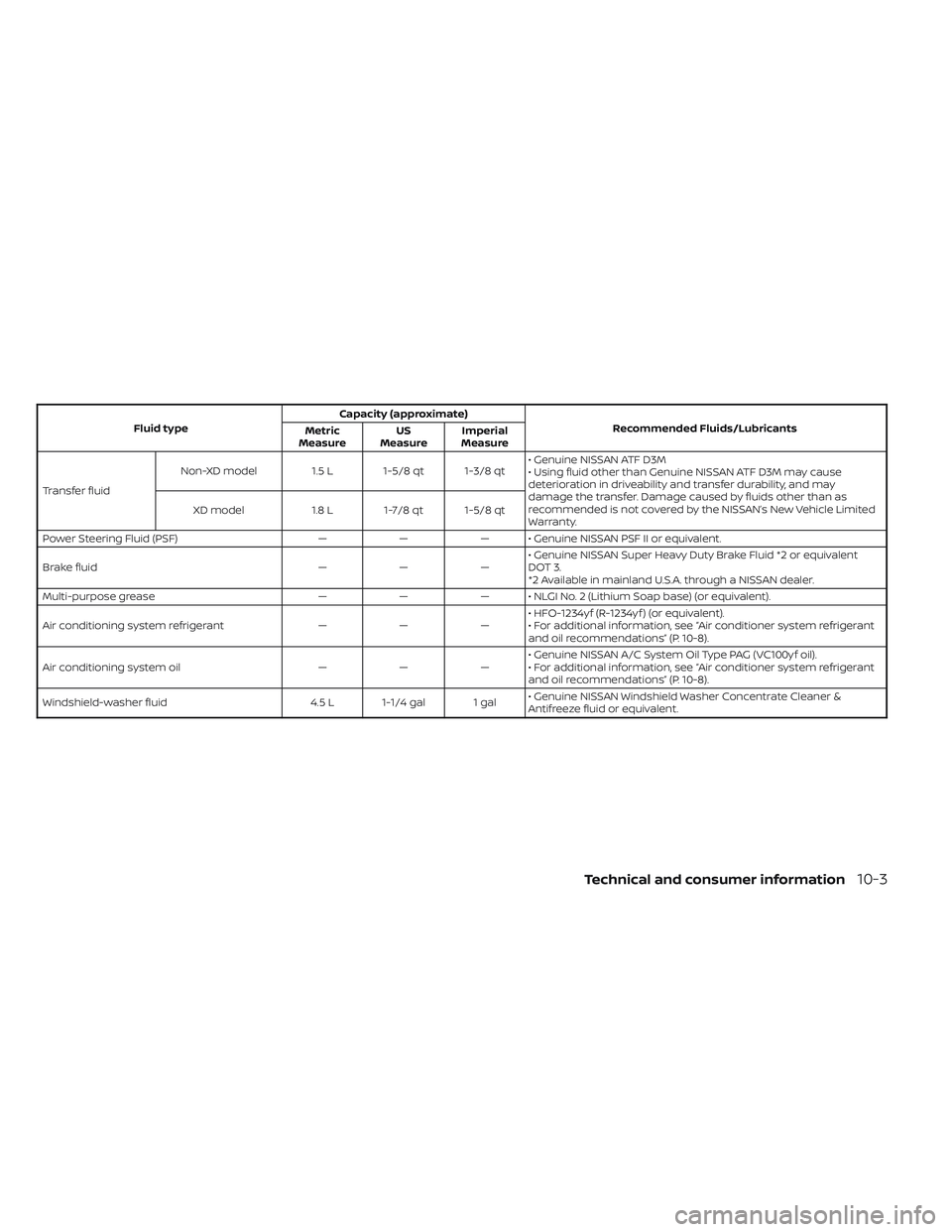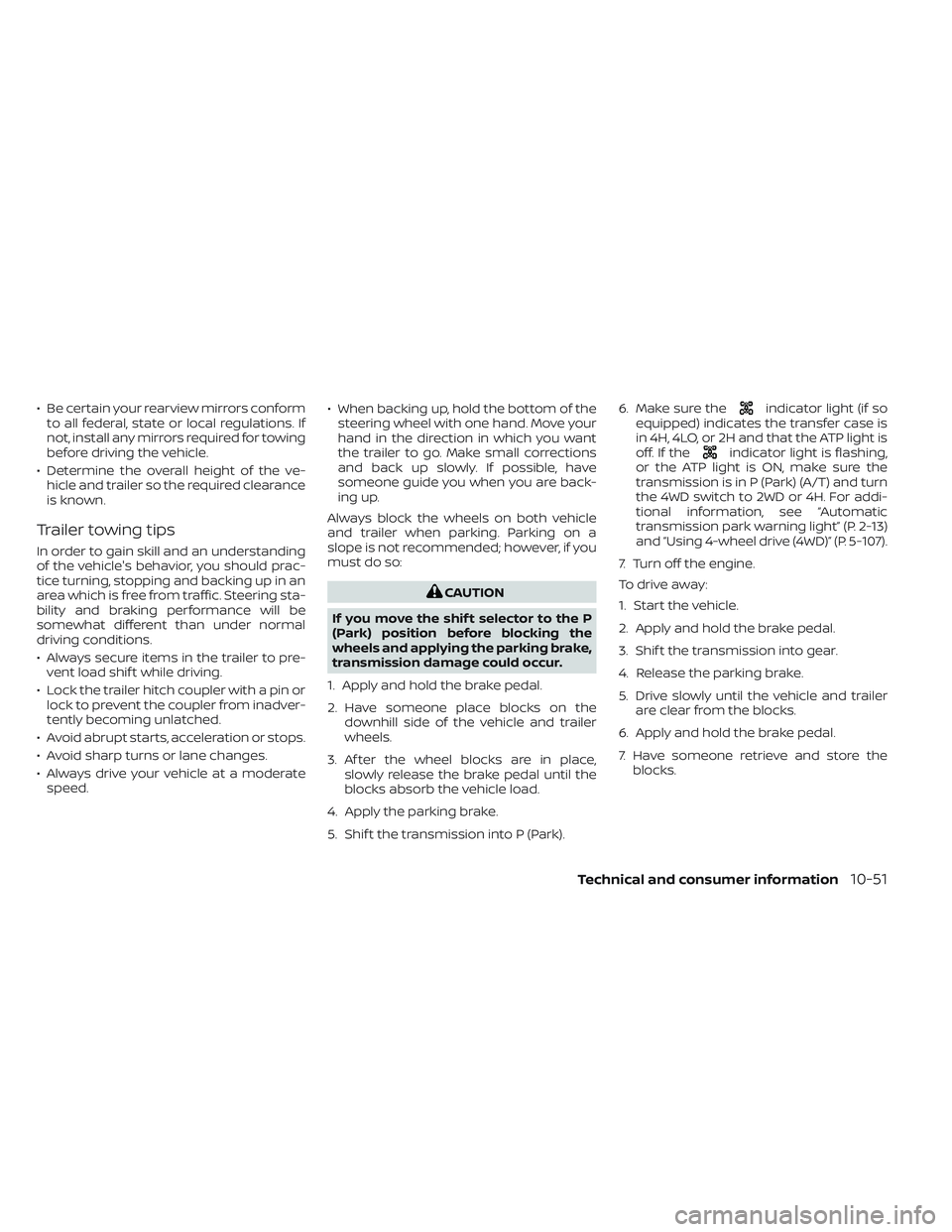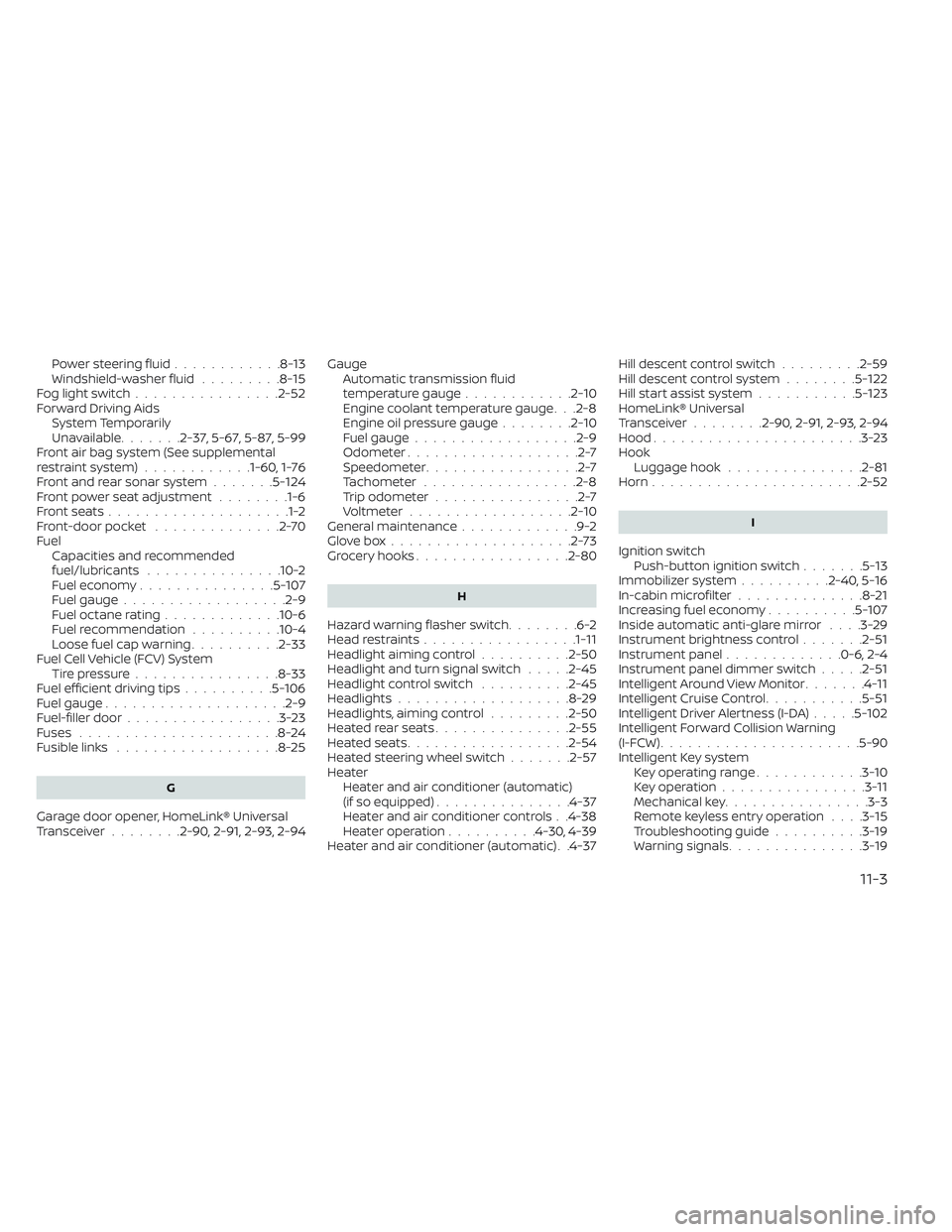2022 NISSAN TITAN steering
[x] Cancel search: steeringPage 565 of 635

Fluid typeCapacity (approximate)
Recommended Fluids/Lubricants
Metric
Measure US
Measure Imperial
Measure
Transfer fluid Non-XD model
1.5 L 1-5/8 qt 1-3/8 qt • Genuine NISSAN ATF D3M
• Using fluid other than Genuine NISSAN ATF D3M may cause
deterioration in driveability and transfer durability, and may
damage the transfer. Damage caused by fluids other than as
recommended is not covered by the NISSAN’s New Vehicle Limited
Warranty.
XD model
1.8 L 1-7/8 qt 1-5/8 qt
Power Steering Fluid (PSF) ——— • Genuine NISSAN PSF II or equivalent.
Brake fluid ———• Genuine NISSAN Super Heavy Duty Brake Fluid *2 or equivalent
DOT 3.
*2 Available in mainland U.S.A. through a NISSAN dealer.
Multi-purpose grease ——— • NLGI No. 2 (Lithium Soap base) (or equivalent).
Air conditioning system refrigerant ———• HFO-1234yf (R-1234yf ) (or equivalent).
• For additional information, see “Air conditioner system refrigerant
and oil recommendations” (P. 10-8).
Air conditioning system oil ———• Genuine NISSAN A/C System Oil Type PAG (VC100yf oil).
• For additional information, see “Air conditioner system refrigerant
and oil recommendations” (P. 10-8).
Windshield-washer fluid 4.5 L 1-1/4 gal 1 gal• Genuine NISSAN Windshield Washer Concentrate Cleaner &
Antifreeze fluid or equivalent.
Technical and consumer information10-3
Page 594 of 635

WARNING
Overloading or improper loading of a
trailer and its cargo can adversely af-
fect vehicle handling, braking and per-
formance and may lead to accidents.
CAUTION
• Do not tow a trailer or haul a heavy
load for the first 500 miles (805 km).
Your engine, axle or other parts could
be damaged.
• For the first 500 miles (805 km) that
you tow a trailer, do not drive over 50
mph (80 km/h) and do not make
starts at full throttle. This helps the
engine and other parts of your ve-
hicle wear in at the heavier load.
Your new vehicle was designed to be used
primarily to carry passengers and cargo.
Remember that towing a trailer places ad-
ditional loads on your vehicle's engine,
drive train, steering, braking and other
systems. A NISSAN Towing Guide (U.S. only) is
available on the website at
www.nissanusa.com. This guide includes
information on trailer towing capability and
the special equipment required for proper
towing.
MAXIMUM LOAD LIMITS
Maximum trailer loads
Never allow the total trailer load to exceed
the value specified in the “Towing load/
specification” chart (P. 10-36). The total
trailer load equals trailer weight plus its
cargo weight.
•
When towing a trailer load of 3,500 lbs.
(1,587 kg) or more, trailers with a brake
system MUST be used.
The maximum GCWR should not exceed
the value specified in the following “Towing
load/specification” chart (P. 10-36). The GCWR equals the combined weight of
the towing vehicle (including passengers
and cargo) plus the total trailer load. Tow-
ing loads greater than these or using im-
proper towing equipment could adversely
affect vehicle handling, braking and
performance.
The ability of your vehicle to tow a trailer is
not only related to the maximum trailer
loads, but also the places you plan to tow.
Tow weights appropriate for level highway
driving may have to be reduced for low
traction situations (for example, on slippery
boat ramps).
LTI0161
TOWING A TRAILER
10-32Technical and consumer information
Page 613 of 635

• Be certain your rearview mirrors conformto all federal, state or local regulations. If
not, install any mirrors required for towing
before driving the vehicle.
• Determine the overall height of the ve- hicle and trailer so the required clearance
is known.
Trailer towing tips
In order to gain skill and an understanding
of the vehicle's behavior, you should prac-
tice turning, stopping and backing up in an
area which is free from traffic. Steering sta-
bility and braking performance will be
somewhat different than under normal
driving conditions.
• Always secure items in the trailer to pre-vent load shif t while driving.
• Lock the trailer hitch coupler with a pin or lock to prevent the coupler from inadver-
tently becoming unlatched.
• Avoid abrupt starts, acceleration or stops.
• Avoid sharp turns or lane changes.
• Always drive your vehicle at a moderate speed. • When backing up, hold the bottom of the
steering wheel with one hand. Move your
hand in the direction in which you want
the trailer to go. Make small corrections
and back up slowly. If possible, have
someone guide you when you are back-
ing up.
Always block the wheels on both vehicle
and trailer when parking. Parking on a
slope is not recommended; however, if you
must do so:
CAUTION
If you move the shif t selector to the P
(Park) position before blocking the
wheels and applying the parking brake,
transmission damage could occur.
1. Apply and hold the brake pedal.
2. Have someone place blocks on the downhill side of the vehicle and trailer
wheels.
3. Af ter the wheel blocks are in place, slowly release the brake pedal until the
blocks absorb the vehicle load.
4. Apply the parking brake.
5. Shif t the transmission into P (Park). 6. Make sure the
indicator light (if so
equipped) indicates the transfer case is
in 4H, 4LO, or 2H and that the ATP light is
off. If the
indicator light is flashing,
or the ATP light is ON, make sure the
transmission is in P (Park) (A/T) and turn
the 4WD switch to 2WD or 4H. For addi-
tional information, see “Automatic
transmission park warning light” (P. 2-13)
and “Using 4-wheel drive (4WD)” (P. 5-107).
7. Turn off the engine.
To drive away:
1. Start the vehicle.
2. Apply and hold the brake pedal.
3. Shif t the transmission into gear.
4. Release the parking brake.
5. Drive slowly until the vehicle and trailer are clear from the blocks.
6. Apply and hold the brake pedal.
7. Have someone retrieve and store the blocks.
Technical and consumer information10-51
Page 614 of 635

• While going downhill, the weight of thetrailer pushing on the tow vehicle may
decrease overall stability. Therefore, to
maintain adequate control, reduce your
speed and shif t to a lower gear. Avoid
long or repeated use of the brakes when
descending a hill, as this reduces their
effectiveness and could cause overheat-
ing. Shif ting to a lower gear instead pro-
vides “engine braking” and reduces the
need to brake as frequently.
• If the engine coolant temperature rises to a high temperature, see “If your vehicle
overheats” (P. 6-12).
• Trailer towing requires more fuel than normal circumstances.
• Avoid towing a trailer for your vehicle's first 500 miles (805 km).
• For the first 500 miles (805 km) that you do tow, do not drive over 50 mph (80
km/h).
• Have your vehicle serviced more of ten than at intervals specified. For additional
information, see the “Maintenance and
schedules” section of this manual.
• When making a turn, your trailer wheels will be closer to the inside of the turn than
your vehicle wheels. To compensate for
this, make a larger than normal turning
radius during the turn. • Crosswinds and rough roads will ad-
versely affect vehicle/trailer handling,
possibly causing vehicle sway. When be-
ing passed by larger vehicles, be pre-
pared for possible changes in crosswinds
that could affect vehicle handling.
Trailer Sway Assist :
To minimize trailer sway, your vehicle may
apply braking to individual wheels based
on input from your vehicle sensors and ve-
hicle speed. Trailer sway control is a func-
tion of the Vehicle Dynamic Control (VDC)
system and is active when the VDC func-
tion is enabled.
CAUTION
If the VDC-OFF switch is on (meaning
VDC system OFF), the Trailer Sway As-
sist is also disabled
When Trailer Sway Assist is in operation, the
VDC warning light blinks. When vehicle con-
trol is regained, VDC warning light will turn
OFF.
For additional information about the VDC
system, see “Vehicle Dynamic Control (VDC)
OFF switch” (P. 2-58) and “Vehicle Dynamic
Control (VDC) system” (P. 5-120). If Trailer Sway Assist activates, do the
following:
1. Take your foot off the accelerator pedal
to allow the vehicle to coast and steer as
straight ahead as the road conditions
allow. This combination will help stabilize
the vehicle
CAUTION
Do not try to correct trailer sway by
steering or applying the brakes.
2. When the trailer sway stops, gently apply the brakes and pull to the side of the
road in a safe area.
3. Try to rearrange the trailer load so it is balanced. For additional information,
see “Pre-towing tips” (P. 10-50).
NOTE:
Trailer Sway Assist cannot reduce trailer
sway in all situations.
• Be careful when passing other vehicles.Passing while towing a trailer requires
considerably more distance than normal
passing. Remember, the length of the
trailer must also pass the other vehicle
before you can safely change lanes.
10-52Technical and consumer information
Page 625 of 635

Power steering fluid............8-13Windshield-washer fluid.........8-15Fog light switch................2-52Forward Driving AidsSystem Temporarily
Unavailable
.......2-37, 5-67, 5-87, 5-99Front air bag system (See supplemental
restraint system)............1-60, 1-76Front and rear sonar system.......5-124Front power seat adjustment........1-6Front seats....................1-2Front-door pocket..............2-70FuelCapacities and recommended
fuel/lubricants
...............10-2Fuel economy...............5-107Fuel gauge................. .2-9Fuel octane rating.............10-6Fuel recommendation..........10-4Loose fuel cap warning..........2-33Fuel Cell Vehicle (FCV) System
Tire pressure................8-33Fuel efficient driving tips..........5-106Fuel gauge................... .2-9Fuel-filler door.................3-23Fuses......................8-24Fusible links..................8-25
G
Garage door opener, HomeLink® Universal
Transceiver........2-90, 2-91, 2-93, 2-94
Gauge
Automatic transmission fluid
temperature gauge
............2-10Engine coolant temperature gauge. . .2-8Engine oil pressure gauge........2-10Fuel gauge................. .2-9Odometer...................2-7Speedometer.................2-7Tachometer.................2-8Trip odometer................2-7Voltmeter..................2-10General maintenance.............9-2Glove box....................2-73Grocery hooks.................2-80
H
Hazard warning flasher switch........6-2Head restraints.................1-11Headlight aiming control..........2-50Headlight and turn signal switch.....2-45Headlight control switch..........2-45Headlights...................8-29Headlights, aiming control.........2-50Heated rear seats...............2-55Heated seats................. .2-54Heated steering wheel switch.......2-57Heater
Heater and air conditioner (automatic)
(if so equipped)
...............4-37Heater and air conditioner controls. .4-38Heater operation..........4-30, 4-39Heater and air conditioner (automatic). .4-37
Hill descent control switch.........2-59Hill descent control system........5-122Hill start assist system...........5-123HomeLink® Universal
Transceiver........2-90, 2-91, 2-93, 2-94Hood.......................3-23HookLuggage hook...............2-81Horn...................... .2-52
I
Ignition switch
Push-button ignition switch.......5-13Immobilizer system..........2-40, 5-16In-cabin microfilter..............8-21Increasing fuel economy..........5-107Inside automatic anti-glare mirror. . . .3-29Instrument brightness control.......2-51Instrument panel.............0-6, 2-4Instrument panel dimmer switch.....2-51Intelligent Around View Monitor.......4-11Intelligent Cruise Control...........5-51Intelligent Driver Alertness (I-DA).....5-102Intelligent Forward Collision Warning
(I-FCW)..................... .5-90Intelligent Key system
Key operating range............3-10Key operation................3-11Mechanical key................3-3Remote keyless entry operation. . . .3-15Troubleshooting guide..........3-19Warning signals...............3-19
11-3
Page 627 of 635

N
NISSAN Intelligent Key®..........3-2,3-9NISSAN Vehicle Immobilizer
System..................2-40, 5-16NissanConnect® Owner's Manual......4-2
O
Octane rating (See fuel octane rating). .10-6Odometer....................2-7Oil
Capacities and recommended
fuel/lubricants
...............10-2Changing engine oil.............8-7Changing engine oil filter.........8-7Checking engine oil level..........8-7Engine oil...................8-7Engine oil and oil filter
recommendation.............10-7Engine oil viscosity.............10-7Outside mirrors................3-30Overhead sunglasses holder........2-76OverheatIf your vehicle overheats.........6-12Owner's manual order form........10-59Owner's manual/service manual
order information..............10-59
P
ParkingParking brake operation.........5-23Parking/parking on hills.........5-115Parking brake.................5-23Personal lights................ .2-90Power
Front seat adjustment...........1-6Power door locks..............3-6Power outlet.............2-65, 2-66Powerrearwindows...........2-83Power steering fluid............8-13Power steering system.........5-116Power windows..............2-82Rear power windows...........2-83Power inverter switch............2-61Power outlet..............2-65, 2-66Power steering................5-116Power steering fluid..............8-13PrecautionsMaintenance precautions.........8-2On-pavement and off-road
driving precautions.............5-8Precautions on booster
seats...........1-34, 1-40, 1-44, 1-49Precautions on child
restraints........1-34, 1-40, 1-44, 1-49Precautions on seat belt usage.....1-16Precautions on supplemental
restraint system...........1-53, 1-68Precautions when starting
and driving...............5-4, 5-11Push starting..................6-12
R
RadioCar phone or CB radio..........4-82Rain sensor.................. .2-43Readiness for inspection maintenance (I/M)
test...................... .10-58Rear Automatic Braking (RAB).......5-75Rear center seat belt.............1-23Rear Cross Traffic Alert (RCTA).......5-42Rear Door Alert.............2-34, 2-64Rear power windows.............2-83Rear seat.....................1-4Rear Seat Infotainment (RSI) System. . .4-43Rear sliding window.............2-85Rear sonar system OFF switch.......2-62Rear window and/or outside mirror
defroster switch................2-44Rearview mirror................3-29RearView Monitor................4-3Recommended Fluids............10-2Recorders
Event Data................ .10-59Refrigerant recommendation.......10-8Registering a vehicle in another
country.................... .10-15Remote Engine Start.........3-20,5-18Reporting safety defects (US only). . . .10-57
S
Safety
Child safety rear door lock.........3-9
11-5
Page 628 of 635

Child seat
belts........1-28,1-34, 1-40, 1-44, 1-49Reporting safety defects
(US only)................. .10-57Seat
Memory seat............3-38, 3-40Seat adjustmentFront manual seat adjustment......1-4Front power seat adjustment.......1-6Seat beltChild safety.................1-25Infants and small children........1-26Injured person................1-19Larger children...............1-26Precautions on seat belt usage.....1-16Pregnant women..............1-19Rear center seat belt...........1-23Seat belt extenders............1-24Seat belt maintenance..........1-24Seat belts................1-16,7-7Shoulder belt height adjustment. . . .1-24Three-point type with retractor.....1-19Seat belt extenders..............1-24Seat belt warning light............2-16Seatback pockets...............2-71SeatsAdjustment..................1-2Front seats..................1-2Heated seats................2-54Manual front seat adjustment......1-4Rear seat.................. .1-4Security indicator light............2-16Security system (NISSAN Vehicle Immobilizer
System), engine start.........2-40, 5-16
Security systems
Vehicle security system.........2-39Self-adjusting brakes.............8-23Service manual order form........10-59Servicing air conditioner...........4-42Shif tingAutomatic transmission.........5-20Shoulder belt height adjustment......1-24Side air bag system (See supplemental side
air bag, curtain and rollover air bag
systems)
.....................1-79Snow plow................. .10-55Spark plug replacement...........8-20Spark plugs...................8-20Specifications.................10-9Speedometer..................2-7Speedometer and odometer........2-6SRS warning label...............1-83Stability control................5-120Standard maintenance............9-8Starting
Before starting the engine........5-16Jump starting............6-10,8-19Precautions when starting
and driving...............5-4, 5-11Push starting................6-12Starting the engine............5-17Starting the engine..............5-17SteeringPower steering fluid............8-13Power steering system.........5-116Steering wheel.................3-26Stop light................... .8-30Storage.....................2-70
Storage tray..................2-74Sun visors....................3-28Sunglasses case................2-76Sunglasses holder..............2-76Sunroof..................2-86, 7-5Supplemental air bag warning
labels...................... .1-83Supplemental air bag warning
light....................1-83, 2-16Supplemental front impact air bag
system..................1-60, 1-76Supplemental restraint system
Information and warning labels.....1-83Precautions on supplemental
restraint system...........1-53, 1-68Supplemental restraint system
(Supplemental air bag system).......1-53SwitchAutolight switch..............2-45Automatic power window switch. . .2-84Electronic locking rear differential
(E-Lock) system switch..........2-60Fog light switch..............2-52Hazard warning flasher switch......6-2Headlight aiming control.........2-50Headlight and turn signal switch. . . .2-45Headlight control switch.........2-45Hill descent control switch........2-59Instrument brightness control.....2-51Power door lock switch..........3-6Power inverter switch...........2-61Rear sonar system OFF switch.....2-62Tow mode switch.............2-63Turn signal switch.............2-51
11-6